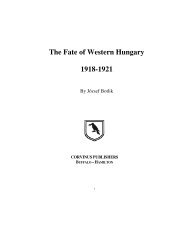The Tsangos of Romania - Corvinus Library - Hungarian History
The Tsangos of Romania - Corvinus Library - Hungarian History
The Tsangos of Romania - Corvinus Library - Hungarian History
You also want an ePaper? Increase the reach of your titles
YUMPU automatically turns print PDFs into web optimized ePapers that Google loves.
pop up like Nádas, Szöcs, Karácsonykö, Tamás, Ravaszfalva,and Lukácsfalva in the documents. From 1510, Tatros becamethe centre <strong>of</strong> the Moldavian bishopric since that is the first townwhere the catholic religion is reestablished. <strong>The</strong> city <strong>of</strong> Bakósoon took over and from the 16th century, it became thereligious centre while most <strong>of</strong> the bishoprics had vanished bythis time.In 1571, Mihály Thabuk , the Franciscan priest <strong>of</strong>Tatros, who originaly came from Szeged (Hungary), succeededin converting 2000 Hussites in the towns <strong>of</strong> Husz and Románback to catholicism. Till the 17th century, catholicism was themajor religion in both Transylvania and Moldavia, but after thatReformation appeared and while Moldavia remained catholic,Transylvania was overrun with it.In 1591, a census is held by the Voivode <strong>of</strong> Moldavia,Ferenc Sánta, and according to his calculations 497,000 peoplelived in the country and out <strong>of</strong> those 15,000-20,000 werecatholics which means either <strong>Hungarian</strong> or German. (InMoldavia being a catholic automatically means that the person iseither a <strong>Hungarian</strong> or a German.) In 1590, Bernát Quirinibecomes the head <strong>of</strong> the Moldavian church. He was aconscientious priest and tried to help his people but in 1603,wrote in despair: "<strong>The</strong> Tartans have destroyed most <strong>of</strong> ourchurches", then in 1604, "<strong>The</strong> Tartars have captured over100,000 men from Transylvania and the number <strong>of</strong> the fallen inthe battles is innumerable". Quirini also became the victim <strong>of</strong>one <strong>of</strong> these raids by the Tartans in 1604.<strong>The</strong>re is a document in the hands <strong>of</strong> the RumanianAcademy from 1605, in which an anonymous writer listed 15parishes in Moldavia:1 Szucsava: two catholic churches from stone, two priests2 Jászvásár: one stone and one wooden church3 Kotnár: three stone and two wooden churches, one germanpriest4 Szeret: one church5 Herló: one stone church6 Moldvabánya: two stone churches7 Németvásár: one church one german priest8 Karácsonykö: one church9 Bákó: two churches there is a franciscan cloister1o Forrófalva: one church
















